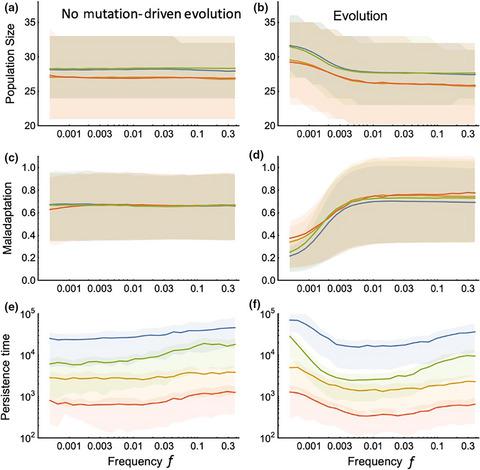当前位置:
X-MOL 学术
›
Ecol. Evol.
›
论文详情
Our official English website, www.x-mol.net, welcomes your
feedback! (Note: you will need to create a separate account there.)
Evolutionary tracking is determined by differential selection on demographic rates and density dependence.
Ecology and Evolution ( IF 2.3 ) Pub Date : 2020-06-01 , DOI: 10.1002/ece3.6311 Anna Christina Vinton 1 , David Alan Vasseur 1
Ecology and Evolution ( IF 2.3 ) Pub Date : 2020-06-01 , DOI: 10.1002/ece3.6311 Anna Christina Vinton 1 , David Alan Vasseur 1
Affiliation

|
Recent ecological forecasts predict that ~25% of species worldwide will go extinct by 2050. However, these estimates are primarily based on environmental changes alone and fail to incorporate important biological mechanisms such as genetic adaptation via evolution. Thus, environmental change can affect population dynamics in ways that classical frameworks can neither describe nor predict. Furthermore, often due to a lack of data, forecasting models commonly describe changes in population demography by summarizing changes in fecundity and survival concurrently with the intrinsic growth rate (r ). This has been shown to be an oversimplification as the environment may impose selective pressure on specific demographic rates (birth and death) rather than directly on r (the difference between the birth and death rates). This differential pressure may alter population response to density, in each demographic rate, further diluting the information combined to produce r . Thus, when we consider the potential for persistence via adaptive evolution, populations with the same r can have different abilities to persist amidst environmental change. Therefore, we cannot adequately forecast population response to climate change without accounting for demography and selection on density dependence. Using a continuous‐time Markov chain model to describe the stochastic dynamics of the logistic model of population growth and allow for trait evolution via mutations arising during birth events, we find persistence via evolutionary tracking more likely when environmental change alters birth rather than the death rate. Furthermore, species that evolve responses to changes in the strength of density dependence due to environmental change are less vulnerable to extinction than species that undergo selection independent of population density. By incorporating these key demographic considerations into our predictive models, we can better understand how species will respond to climate change.
中文翻译:

进化跟踪是由人口比率和密度依赖性的差异选择决定的。
最近的生态预测预测,到 2050 年,全球约 25% 的物种将灭绝。然而,这些估计主要仅基于环境变化,未能纳入重要的生物机制,例如通过进化进行遗传适应。因此,环境变化可以以经典框架无法描述或预测的方式影响人口动态。此外,由于缺乏数据,预测模型通常通过总结生育力和生存率的变化以及内在增长率(r)来描述人口统计的变化。这已被证明过于简单化,因为环境可能会对特定的人口统计率(出生率和死亡率)而不是直接对r(出生率和死亡率之间的差异)施加选择性压力。这种压差可能会改变每个人口比率中人口对密度的反应,进一步稀释产生r 的信息。因此,当我们考虑通过适应性进化实现持久化的潜力时,具有相同r的种群在环境变化中可能具有不同的持久化能力。因此,如果不考虑人口统计学和对密度依赖性的选择,我们就无法充分预测人口对气候变化的反应。使用连续时间马尔可夫链模型来描述人口增长逻辑模型的随机动力学,并允许通过出生事件期间发生的突变进行性状进化,我们发现当环境变化改变出生而不是死亡率时,通过进化跟踪更有可能实现持久性。此外,与那些独立于种群密度进行选择的物种相比,由于环境变化而对密度依赖性强度变化做出反应的物种更不容易灭绝。通过将这些关键的人口统计因素纳入我们的预测模型中,我们可以更好地了解物种将如何应对气候变化。
更新日期:2020-06-26
中文翻译:

进化跟踪是由人口比率和密度依赖性的差异选择决定的。
最近的生态预测预测,到 2050 年,全球约 25% 的物种将灭绝。然而,这些估计主要仅基于环境变化,未能纳入重要的生物机制,例如通过进化进行遗传适应。因此,环境变化可以以经典框架无法描述或预测的方式影响人口动态。此外,由于缺乏数据,预测模型通常通过总结生育力和生存率的变化以及内在增长率(r)来描述人口统计的变化。这已被证明过于简单化,因为环境可能会对特定的人口统计率(出生率和死亡率)而不是直接对r(出生率和死亡率之间的差异)施加选择性压力。这种压差可能会改变每个人口比率中人口对密度的反应,进一步稀释产生r 的信息。因此,当我们考虑通过适应性进化实现持久化的潜力时,具有相同r的种群在环境变化中可能具有不同的持久化能力。因此,如果不考虑人口统计学和对密度依赖性的选择,我们就无法充分预测人口对气候变化的反应。使用连续时间马尔可夫链模型来描述人口增长逻辑模型的随机动力学,并允许通过出生事件期间发生的突变进行性状进化,我们发现当环境变化改变出生而不是死亡率时,通过进化跟踪更有可能实现持久性。此外,与那些独立于种群密度进行选择的物种相比,由于环境变化而对密度依赖性强度变化做出反应的物种更不容易灭绝。通过将这些关键的人口统计因素纳入我们的预测模型中,我们可以更好地了解物种将如何应对气候变化。











































 京公网安备 11010802027423号
京公网安备 11010802027423号